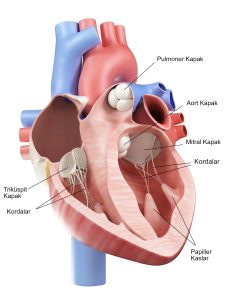What is a Heart Valve?
Heart valves are structures located between the chambers of the heart or between the heart chambers and the main arteries that regulate blood flow according to the pumping function of the heart. There are four valves in the heart. In the left side of the heart, where oxygen-enriched clean blood is pumped into the body, there are the aortic and mitral valves, while on the right side, where deoxygenated blood is pumped to the lungs, there are the tricuspid and pulmonary valves. The leaflets of the mitral and tricuspid valves are attached to the walls of the chambers with tendons called “chordae.” The aortic and tricuspid valves have three leaflets, while the mitral and pulmonary valves have two.

What is the Function of Heart Valves?
When the heart contracts for its pumping function, the heart valves open and allow the passage of blood. Between heartbeats, they quickly close to prevent blood from flowing back. Any disruption in this normal sequence will hinder the heart’s effective pumping function. Heart valves facilitate the passage of blood from the heart to all organs.
What are the Causes of Heart Valve Diseases?
Heart valve diseases account for 1-2% of all deaths worldwide. Recent rapid developments in artificial valve technology have led to effective and permanent surgical treatment options for heart valve surgeries.
Pathologies that either obstruct the passage of blood or cause insufficiency when valves allow the passage of blood may require surgical correction after a certain stage. Damage to the annular tissue around the valves, the valves themselves, or the tendons can lead to heart valve diseases.
The disease can affect a single valve or multiple valves simultaneously. In such cases, the disease usually begins in one valve and then disrupts the functioning of other valves according to the working principles of the heart.
The main causes of heart valve diseases include congenital heart valve diseases, rheumatic fever at a young age, infections, deterioration due to aging, coronary heart diseases, and aortic aneurysms.
What are Heart Valve Diseases?
Heart valve diseases are most commonly observed in the mitral and aortic valves. Pulmonary and tricuspid valves are less frequently affected. Degenerative (wear-related) heart valve diseases are often seen as stenosis (narrowing) in the aortic valve and insufficiency in the mitral valve. When heart valve diseases reach the surgical stage, they often create both stenosis and insufficiency. The prevalence of aortic valve stenosis increases after the age of 70, correlating with the increasing average age of healthy populations.
The main heart valve diseases include:
- Aortic Valve Stenosis
- Aortic Valve Insufficiency
- Mitral Valve Stenosis
- Mitral Valve Insufficiency
- Mitral Valve Prolapse
- Tricuspid Valve Stenosis
- Tricuspid Valve Insufficiency
- Pulmonary Valve Stenosis
- Pulmonary Valve Insufficiency
- .Combined Valve Diseases
What are the Symptoms of Heart Valve Diseases?
Heart valve diseases may not show any symptoms in the early stages, and patients may not be aware of their diseases for a long time. However, as heart problems increase, symptoms begin to appear in patients. Shortness of breath, palpitations, arrhythmia, chest pain, chest tightness, feeling faint, fainting, imbalance, weakness, leg swelling, coughing up blood, and inability to lie on the back are typical signs of heart valve disease. Several of these symptoms may occur simultaneously. The manifestation of symptoms of heart valve diseases plays a significant role in the decision-making process for surgery.
What are the Methods for Diagnosis of Heart Valve Diseases?
Diagnosis of valve disease can be made by echocardiography and angiography for patients who apply to a cardiologist due to complaints. Valve diseases that do not require surgery are followed up with periodic echocardiographic examinations. Sometimes, a diagnosis of valve disease can be made incidentally during the investigation of another heart disease.

How are Heart Valve Diseases Treated?
In the treatment of heart valve diseases, the patient’s complaints, physical examination, and the results of necessary tests are of critical importance. In non-surgical valve diseases, patients can be followed up with medical treatments and periodic echocardiography for the long term. In the treatment protocol for valve diseases, it is important to determine and closely monitor accompanying diseases (arrhythmia, hypertension, diabetes, etc.). Treatment planning should take into account the patient’s age, general condition, past medical history, medications used, nutrition, and lifestyle. However, if the degree of valve disorder requires surgery, appropriate surgical planning is made. Valve surgeries are generally performed as replacement or reconstruction. In the surgery of heart valve diseases, repairing the patient’s own valve is preferred. Valve repair is shown as the ideal method for patients. With newly developed techniques and advances in technology, many heart valves can now be repaired. Thus, patients continue their lives with their original valves, and there is no need for lifelong use of blood-thinning drugs. If valve replacement is necessary for patients, attention is paid to the fact that the implanted valve is the newest and most durable.

